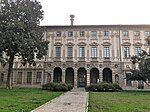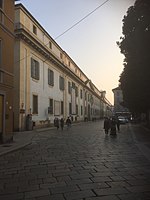Pavia Civic Museums

The Civic Museums of Pavia (Musei Civici di Pavia) are a number of museums in Pavia, Lombardy, northern Italy. They are housed in the Castello Visconteo, or Visconti Castle, built in 1360 by Galeazzo II Visconti, soon after taking the city, a free city-state until then. The credited architect is Bartolino da Novara. The castle used to be the main residence of the Visconti family, while the political capital of the state was Milan. North of the castle a wide park was enclosed, also including the Certosa of Pavia, founded 1396 according to a vow of Gian Galeazzo Visconti, meant to be a sort of private chapel of the Visconti dynasty. The Battle of Pavia (1525), climax of the Italian Wars, took place inside the castle park. The Civic Museums of Pavia include the Pinacoteca Malaspina, Museo Archeologico and Sala Longobarda, Sezioni Medioevale e Rinascimentale Quadreria dell’800 (Collezione Morone), Museo del Risorgimento, Museo Robecchi Bricchetti, and the Cripta di Sant’Eusebio.
Excerpt from the Wikipedia article Pavia Civic Museums (License: CC BY-SA 3.0, Authors, Images).Pavia Civic Museums
Piazza Castello, Pavia Città Giardino
Geographical coordinates (GPS) Address Nearby Places Show on map
Geographical coordinates (GPS)
| Latitude | Longitude |
|---|---|
| N 45.19 ° | E 9.1583333333333 ° |
Address
Piazza Castello
27100 Pavia, Città Giardino
Lombardy, Italy
Open on Google Maps











